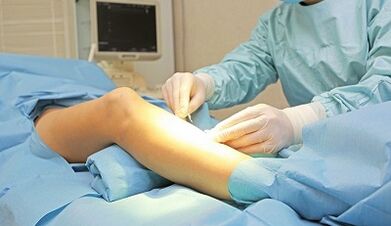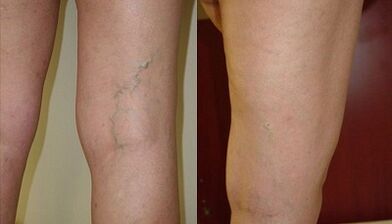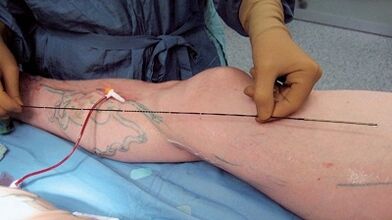Conservative treatment methods are effective only in the early stages of varicose veins.And since the first signs generally remain unnoticed, the pathology continues to develop, thus reducing the effectiveness of the medications used.If symptoms worsen significantly, the only option to eliminate varicose veins is surgery.A special place is occupied by rehabilitation, which requires patients to comply with medical recommendations.
Surgical indications

In case of varicose veins, surgical treatment is prescribed in certain cases.
In particular, surgical intervention is indicated for patients presenting:
- significant vascular damage, which can be determined by visual examination;
- symptoms in the form of swelling, constant pain and a feeling of heaviness;
- significant risk of thrombophlebitis and trophic ulcers.
Varicose vein surgery is appropriate when the use of medications does not bring the desired results.It is important to prevent the disease from developing to the point where surgical treatment is unnecessary.
For some patients, leg varicose vein surgery may be contraindicated.
Contraindications
Late-stage surgery is often inappropriate;therefore, varicose veins are treated with various medications.They help to slightly reduce the severity of the disease, but cannot completely eliminate it.
Patients suffering from:
- inflammatory skin diseases at the site of development of venous pathology (for example, erysipelas or eczema);
- cardiovascular disorders (coronary heart disease, hypertension, heart failure);
- acute form of phlebitis;
- infectious diseases (surgical intervention is possible after recovery);
- venous thrombosis, pulmonary embolism (history);
- obliterating atherosclerosis of the vessels of the lower limbs.
Surgical treatment to eliminate varicose veins is contraindicated in patients over 70 years old as well as in pregnant women.
Preparing for surgery
A consultation with a phlebologist will help you properly prepare for the upcoming surgical treatment.The patient has the right to ask any questions that interest him regarding the operation.
You should also describe the symptoms present as precisely as possible, talk about a possible intolerance to certain medications and make sure you are well informed about the medications you are currently taking.
The attending physician directs the patient to a number of diagnostic interventions:
- blood and urine tests;
- fluorography;
- electrocardiography;
- duplex ultrasound.
The preparatory phase requires compliance with certain conditions:
- 3 days before surgery, the patient must follow a slag-free diet, that is, fried, salty, spicy products, as well as meat and flour products are prohibited.
- The last meal and fluid consumption takes place 8 hours before surgery.
- For at least 3 days you should forget about alcohol and cigarettes.
- You will need to wax the leg on which the operation will be performed and use a razor.
- In case of ulcers, hematomas or any skin lesions, you should inform your doctor.
If the patient drives a car, he or she must arrange for a relative or friend to pick them up after discharge.Driving is currently prohibited.
When preparing for surgery, the patient wants to know what type of surgical intervention is indicated for him and how much this treatment costs.If a patient needs to undergo vein surgery, the price is influenced by many factors: the stage of the disease, the length of the vessel affected by the varicose veins, anesthesia, etc.
Methods for eliminating varicose veins
Since there are many types of surgical treatment of varicose veins, the choice of a specific technique is made based on diagnostic data.In some cases, the venous vessel is partially or completely removed, in others, the veins deformed due to varicose veins are sealed or narrowed using a special substance.
Phlebectomy
Type of surgical treatment in which areas of blood vessels where varicose veins are present are excised.After removal, blood will flow through the deep veins.
The operation takes place as follows:
- Once the anesthesia has been carried out, the surgeon makes small incisions (up to 5 mm).
- The vein is removed using a special probe, after which the affected area is resected.
The duration of phlebectomy is 1 to 2 hours.Subsequently, a small scar remains at the operated site.
Microphlebectomy

A great alternative to the previous method.The essence of the technique is that it is not necessary to make 5 mm incisions.A small puncture is enough to carry out all the necessary manipulations with the vein.In addition, healing in this case is much faster and no scars remain.
All types of operations carried out to eliminate varicose veins of the legs go well and lead to complications in very rare cases.
Thanks to this puncture technique, it is possible to get rid of even large varicose veins.
Stripping
This is a type of phlebectomy.With its help, the trunk of the great saphenous vein is removed.The surgeon removes the vessel affected by varicose veins through a small incision using a special probe.Incisions are made at the inguinal fold and ankle on the inside.
Stripping occurs:
- partial– only part of the venous vessel is excised;
- total– the diseased vein is stretched with its small branches.
Carrying out such manipulations requires maximum care from the doctor.If at least one tributary remains uncrossed, the risk of relapse increases considerably.
Sclerotherapy
This is a surgical procedure to eliminate progressive varicose veins, which is minimally invasive and does not require any incisions.The surgeon's actions are aimed at narrowing the lumen of the diseased vessel until its complete disappearance.
To do this, a sclerosant is injected into a vein.The drug promotes irreversible damage to the vessel walls with subsequent lumen proliferation.
Medications specially designed for this purpose are usually used.
Sclerotherapy has several advantages:
- the procedure can be performed on an outpatient basis;
- the patient is allowed to resume daily activities the next day;
- no need for general anesthesia;
- There is no scar after the operation.
A negative point is the probability of varicose veins reforming.The disease can affect veins located next to those where the sclerosant was injected.Up to 10 injections are performed in one procedure and the treatment duration is approximately one hour.
It is necessary to say about the types of sclerotherapy:
- Mousse.The medicine used, on contact with air, forms a foam which fills the cavity of the container.Closure of the lumen occurs in a short time and even a small amount of sclerosant is enough.Additionally, to achieve satisfactory results, 1-2 procedures are carried out, during which the foam is injected a maximum of 3 times.
- Microsclerotherapy.The technique is appropriate in the early stages of the disease.
- Echosclerosis.Prescribed for deep vein injuries.The injection is made using an ultrasound scanner, which makes it possible to clearly distinguish the injection site of the sclerosant, accurately determine the amount of medication and avoid undesirable consequences.
The manipulations carried out are practically painless and patients then recover quickly.
Laser coagulation
This method of treating varicose veins, called endovenous (endovasal) laser coagulation (obliteration), involves the use of a special device - an LED laser.
It is injected into the affected vein and, thanks to its radiation, the internal surfaces of the vessel are welded together.Blood continues to flow through healthy veins and the patient's well-being improves.
Advantages of laser coagulation:
- absence of scars and age spots on the skin;
- performed on an outpatient basis for 1-2 hours;
- local anesthesia is used;
- manipulations are carried out under the control of an ultrasonic device;
- short recovery period.
The success of the operation can be definitively judged after 3 months.The use of a laser guarantees complete relief from the disease without the risk of relapse.
The rehabilitation period after removal of veins
After surgery, the patient must follow certain rules that will minimize the risk of complications and speed up healing:

- Wearing compression stockings is recommended.The attending physician will help him in his choice.At first (about 5 days), underwear is not removed before going to bed, then its use is allowed only during the day.
- To support blood vessels, alcohol and tobacco should be prohibited, since nicotine and alcohol are one of the most common causes of varicose veins.
- You should refrain from excessive physical activity.Even minor injuries to the lower extremities pose a danger.If the patient previously loved sports, he can return to exercise after 1.5-2 months.
- To avoid relapses, water procedures should not be hot.The sauna, hammam and solarium are contraindicated.
- Cosmetic procedures cannot be performed on the operated areas.
- It will be useful to perform therapeutic exercises.
To prevent the reappearance of varicose veins after surgery, during the rehabilitation period you will need to take medications prescribed by your doctor to help the vessels recover.It is undesirable to change the dosage of medications at your own discretion, which leads to undesirable consequences.If signs of deterioration appear, it is important to consult a phlebologist immediately.
The type of surgical intervention is determined based on the individual characteristics of the disease.
Possible complications after surgery
No specialist can guarantee the complete absence of side effects after surgery.Complications may occur depending on the surgical treatment method used.
Phlebectomy and stripping can result in:
- numbness in the lower legs;
- decreased skin sensitivity;
- pain syndrome;
- bleeding;
- hematomas;
- suppuration of the operated area.
After sclerotherapy, the following may appear:
- swelling of ankle and foot;
- pigmentation;
- peeling and itching;
- painful sensations;
- skin burn.
If a laser LED was used, the formation of:
- inflammations;
- darkening of skin areas;
- minor bruising;
- throbbing pain.
The most dangerous complication of any surgical intervention is thrombosis.But its appearance is observed in rare cases.With minimally invasive surgery, the risk of a blood clot is quite low.
Thanks to surgical treatment, it is possible to successfully get rid of a serious illness.The main thing is to find a qualified specialist and not ignore medical recommendations regarding the recovery period.

















